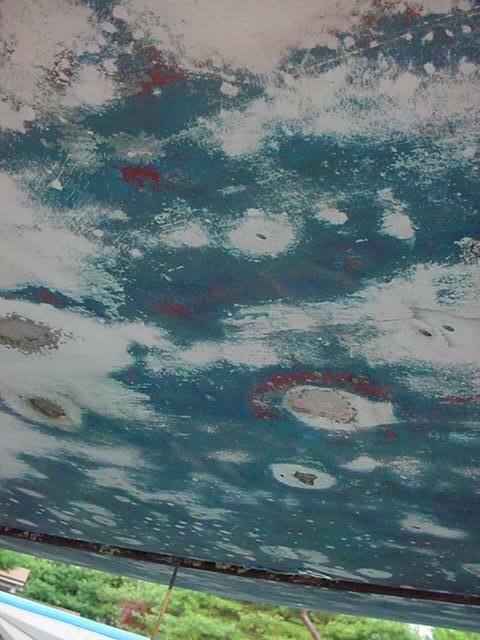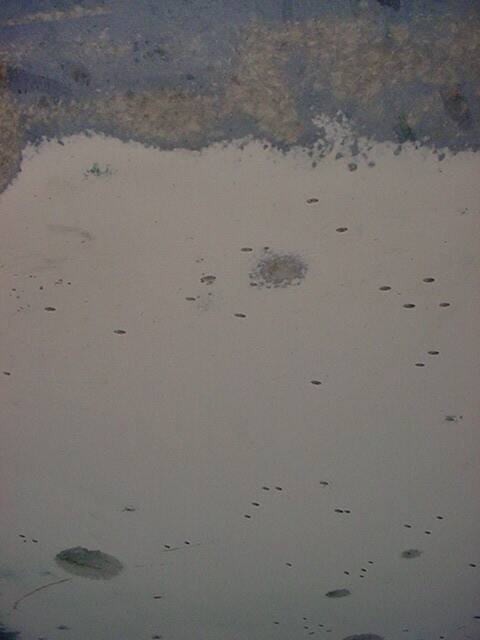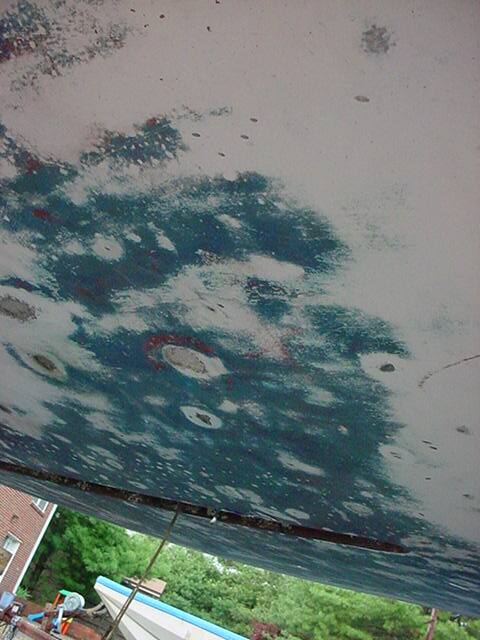Bottom Job, Continued and Continued and
Continued!
I removed all the red bottom paint and some of the blue with stripper
and a DA sander with a 6" pad and 80 grit paper. In the
process of doing that, I sanded through a blister enough that water
came out. Uh oh, the water in the blisters was between the mat
and the fiberglass core. I grabbed the Dremmel and poked about
2,000 holes in every round high spot. This resulted in
identifying an estimated 400 wet blisters,
I have now opened as many of the blisters as I know about. As
Rumsfeld
says, "I have not opened up any blisters I do not know about!" In
these pictures you get an idea of how many test holes I had to drill
with the Dremel.
I opened
the blisters up with a Roto-zip with a router attachment on it and
fiberglass bits. I wore out 4 bits grinding them out. This
gets the boat to the condition shown on the right, with much blue paint
remaining.
In the picture below, some of the largest blisters are shown. By
grinding out the mat around all the water, I cute the dry out time from
months to weeks. Indeed, the blisters dried out in only 2 weeks
if I ground out all the wet mat. After that same 2 weeks,
blisters that had only been opened with the Dremel still had about 1/3
the water still in them.
The blisters are determined to be dry enough by taping a piece of Saran
Wrap over the blisters and letting it sit overnight. If any
moisture remains in the blister, it will readily show on the
Saran Wrap. Pretty low tech, but effective.

It took about 35 hours to get to this point! Now that I know how
to use the stripper, I could cut that down by about 10 hours. The
secret on the stripper is to swab it on thick. Then let it
sit for about 20 or 30 minutes. I used a piece of cardboard to
catch the scrapings and contain them so I didn't end up sitting in
them.
BE SURE TO WEAR EYE PROTECTION when messing with the stripper. I
ended up using 2 pairs of gloves. When putting the stripper on I
used two of the cheap latex gloves. When scrapping it off I used
a latex glove topped with a cloth glove to keep from cutting the latex
glove.
Once the stripper got most of the bottom paint off, I switched to the
DA sander. I tried using a half face respirator and
goggles. That is just not sufficient to keep dust out of one's
eyes. I coughed up the $100 for a full face mask from Grainger
that allows me to work as long as I want without getting anything in my
eyes! A painter's head sock is mandatory as is a Tyvek
coverall. Any place not covered is going to get covered with
toxic bottom paint.
When I started grinding on the fiberglass, I thought I was going to
itch forever! A box fan sure helps to remove the dust!

The next step is to remove the rest of the bottom paint with an air
file.long board sander and 36 grit paper. The air file is 17"
long. It
takes one sheet of paper to go from one side to the other. That
also takes about 2 hours! This is pretty demanding physical work
for a CPA! I have been at it every night since 4/15th and my arms
are now in good enough shape that I have to wait for the air compressor
to catch up. Accordingly, this process could move along quicker
with a bigger air compressor. As it is, I will be one half done
in another 3 or 4 hours. It will take another 6 to 10 hours
to finish the other side. Total time at that point will be
about 50 hours.
Note in the picture to the right I used the DA sander to remove all the
gelcoat around the waterline where is was covered with pox. After
removing the gelcoat with the DA sander, I used the air file to fair
it. This curved area will require much hand sanding with a
long board that is flexible enough to bend around the hull.
I will likely let the blisters dry some more while I get to work on
other stuff. Hopefully, they'll all be dried out in another
couple of weeks. Then I get to fill them, fair them with the long
board and spray a coat of primer to see how well I've done sanding up
to that point!
Bob Keim
S/V The Pursuit, #6195
Nashville, TN



